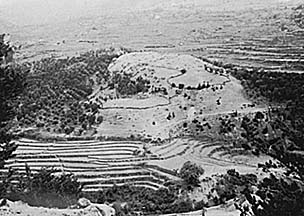 Marlik culture (تپه مارلیک) was discovered in the green and fertile lands of Northern Iran just South of the Caspian Sea. The amazing archeological founds on this site are associated to 10th-12th century BC.
Marlik culture (تپه مارلیک) was discovered in the green and fertile lands of Northern Iran just South of the Caspian Sea. The amazing archeological founds on this site are associated to 10th-12th century BC.
Some researchers believe that Marlik, also known as Cheragh Ali Tapeh, has attained its name from the innumerable snakes that have inhabited it whereas some believe that, Marlik, the name the local villagers gave to the mound, is 'Marda-lik' (place of the Marda or Amarda). There are some significant similarities between the metalwork at Marlik and some of those found at Sialk near Kashan, and as the finds at Sialk are dated as slightly later than those of Marlik, it is suggested that the population around Marlik and Sepid Rood relocated to the central Iranian plateau near Sialk where they were eventually assimilated into the general Median population.
In the excavations performed on this site, a large number of broken earthenware pieces can be noted. Moreover, two tiny statues of cows in admiralty metal, two cylindrical seals, fourteen gold buttons and other unique objects have been discovered. Fabrics from this site have come to hand that determine the fact that weaving was a progressive technology in Iran thousands of years ago, and more so in Gilan. About 11 seals have been discovered in these excavations, and these have interesting designs and patterns on them. There is a seal engraved in the Cuneiform script.
There are remnants of a quadrangular structure with an approximate area of 30 square meters, suggesting a tomb or temple. This hillock was also a site where the local commanders or princes who ruled in the 2nd or 1st millennium BC. were laid to rest. According to the tradition of the times, the dead were buried along with their treasures. About 25 tombs have been discovered, in some of which are human carcasses, along with articles such as earthenware and bronze vessels, decorative buttons, arrows, swords, spears, bronze and earthenware statues, daggers, helmets. The most famous item recovered is the 'Gold Bowl of Marlik', which for a period was included in the design of the 500 rial banknote.
The people who buried their dead at Marlik remain something of a puzzle for history. They seem not to have left any written records, and aside from the cemetery at Marlik there is not very much in the archaeological record to fill out their history. If the original population abandoned the valley soon after the burials, this may explain why the cemetery was forgotten and not looted in the intervening years. This theory still remains unconfirmed, and it remains true that little can be said with any certainty about the people who buried their royalty atop the mound at Marlik. The items recovered at Marlik contain many unusual items which have helped to develop current thinking on the chronology of metal working in late bronze age cultures.
Currently the entire area had been ravaged by illegal digging. A brief survey showed some 2000 holes had been haphazardly dug around the valley, and everything that had been despoiled was now lost.








No comments:
Post a Comment